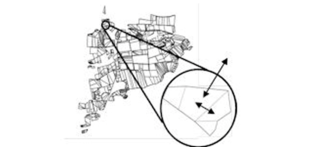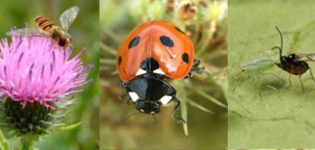 Weeds undergo complex life-cycle dynamics involving the buried seedbank, emerged populations, reproduction, dispersal, gene flow and genetic change. Individual-based models (IBMs) of plant populations have been an integral part of the programme since the late 1990s, finding specific use by predicting coexistence of GM and non-GM traits and trait shifts due to environment and management.
Weeds undergo complex life-cycle dynamics involving the buried seedbank, emerged populations, reproduction, dispersal, gene flow and genetic change. Individual-based models (IBMs) of plant populations have been an integral part of the programme since the late 1990s, finding specific use by predicting coexistence of GM and non-GM traits and trait shifts due to environment and management.
The IBMs developed here have their base in flux-based studies of crop production: each individual explores the environment for a finite resource on which it grows, reproduces and disperses. The emergent properties of the resulting populations are measured in terms of mass, resource, abundance, etc. A range of other approaches are used, including machine-learning techniques for mining large datasets.
Funding: Scottish Government Strategic Research Programme Land Use Theme 2011-16, EU FP7 PURE project.
Previous funding includes: BBSRC Gene flow in Agriculture, University of Abertay; BBSRC LINK on farmland diversity; PhD studentships; EU FP6 SIGMEA project.
For more infomation contact Graham Begg for landscape models and current IBM, Cathy Hawes for trophic interactions, Geoff Squire for weed dynamics and GM coexistence.
Publications
-
Bagavathiannan M.V., Begg G.S., Gulden R.H., Van Acker R.C. 2012. Modelling the dynamics of feral alfalfa populations: implications for novel trait confinement. PLoS ONE 7(6), e39440.
-
Bohan, D.A., Powers, S.J., Champion, G., Haughton, A.J., Hawes, C., Squire, G.R., Cussans, J., Mertens, S.K. 2011. Modelling rotations: can crop sequences explain arable weed seedbank abundance? Weed Research 51, 422-432.
-
Begg G.S., Hockaday S., McNicol J.W., Askew M., Squire G.R. 2006. Modelling the persistence of volunteer oilseed rape (Brassica napus). Ecological Modelling 198: 195-207.
-
Bown, J.L., Pachepsky, E., Eberst, A., Bausenwein, U., Millard, P., Squire, G.R. and Crawford, J.W. 2007. Consequences of intraspecific variation for the structure and function of ecological communities Part 1: Model development and predicted patterns of diversity. Ecological Modelling 207, 264-276.
-
Pachepsky E., Crawford J.W., Bown J.L., Squire G.R. 2001. Towards a general theory of biodiversity. Nature 410, 923-926






